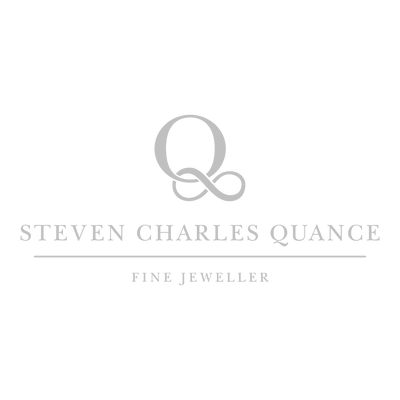Alternative Gemstones: 10 Most-Asked Questions (Answered)
1) Why choose a gemstone instead of a diamond?
Gemstones offer individuality, symbolism and sometimes a friendlier budget. They’re ideal if you want colour, personal meaning (birthstones, memories) or ethical options (lab-grown, responsibly sourced). Sapphires suggest loyalty, rubies passion, emeralds growth; moissanite delivers diamond-like sparkle for less.
2) Are coloured gemstones durable for everyday wear?
Durability varies. On the Mohs scale: diamonds 10, moissanite ~9.25, sapphires/rubies 9 (excellent daily wear). Emeralds ~7.5–8 (need more care). Softer stones (opal, pearl) aren’t ideal for heavy daily wear. Protective settings (bezel/halo) help.
3) What does a sapphire symbolise?
Loyalty, wisdom and fidelity. Classic blue is royal and timeless, but sapphires come in many colours (pink, yellow, green) if you want a unique twist—with great durability.
4) Why are emeralds more delicate?
Emeralds often have natural inclusions (“jardin”) and sit ~7.5–8 Mohs, so they can chip if knocked. Choose protective settings, avoid harsh chemicals/impacts, and enjoy that vivid green with sensible care.
5) What’s the difference between natural and lab-grown gemstones?
Natural stones are mined and valued for rarity and provenance; lab-grown are created in controlled conditions with the same physical/chemical properties, typically more affordable and ethical. Modern lab sapphires, rubies and emeralds look superb.
6) Is moissanite a suitable diamond alternative?
Yes—bright, fiery, durable and budget-friendly. At ~9.25 Mohs it’s excellent for daily wear, and it’s lab-created, which many clients prefer for ethics and price.
7) Which gemstones are most affordable?
Amethyst, garnet and peridot are widely affordable; high-quality rubies/sapphires/emeralds can rival diamond prices. Lab-grown versions and moissanite offer the strongest value for look vs cost.
8) Can gemstones be cut into any shape?
Most can be cut round, oval, pear, cushion, etc., but structure matters. Emeralds suit emerald cuts to protect corners; corundum (sapphire/ruby) allows more flexibility. Good cutting maximises colour and life.
9) What are birthstones and their meanings?
Each month links to a stone (e.g., sapphire for September = loyalty/wisdom). Birthstones personalise engagement rings and add sentimental weight alongside design.
10) Do gemstones retain their value over time?
Top-quality natural rubies, sapphires and emeralds hold value best. Lab-grown and moissanite prioritise beauty/ethics/value over long-term resale. Emotional value often outweighs market value for most couples.
Next steps
- See your options in real time: Design your ring online.
- Ask Steven which stone suits your lifestyle and budget: Book a free consultation.
- Keep learning: The Ultimate Guide to Engagement Rings.
Alternative Gemstones: 10 Most-Asked Questions (Answered)
Diamonds aren’t the only way to tell your story. Here Steven Charles Quance explains the best alternative gemstones for engagement rings—what they mean, how they wear, and how to choose confidently.
1) Why choose a gemstone instead of a diamond?
Gemstones offer individuality, symbolism and sometimes a friendlier budget. They’re ideal if you want colour, personal meaning (birthstones, memories) or ethical options (lab-grown, responsibly sourced). Sapphires suggest loyalty, rubies passion, emeralds growth; moissanite delivers diamond-like sparkle for less.
2) Are coloured gemstones durable for everyday wear?
Durability varies. On the Mohs scale: diamonds 10, moissanite ~9.25, sapphires/rubies 9 (excellent daily wear). Emeralds ~7.5–8 (need more care). Softer stones (opal, pearl) aren’t ideal for heavy daily wear. Protective settings (bezel/halo) help.
3) What does a sapphire symbolise?
Loyalty, wisdom and fidelity. Classic blue is royal and timeless, but sapphires come in many colours (pink, yellow, green) if you want a unique twist—with great durability.
4) Why are emeralds more delicate?
Emeralds often have natural inclusions (“jardin”) and sit ~7.5–8 Mohs, so they can chip if knocked. Choose protective settings, avoid harsh chemicals/impacts, and enjoy that vivid green with sensible care.
5) What’s the difference between natural and lab-grown gemstones?
Natural stones are mined and valued for rarity and provenance; lab-grown are created in controlled conditions with the same physical/chemical properties, typically more affordable and ethical. Modern lab sapphires, rubies and emeralds look superb.
6) Is moissanite a suitable diamond alternative?
Yes—bright, fiery, durable and budget-friendly. At ~9.25 Mohs it’s excellent for daily wear, and it’s lab-created, which many clients prefer for ethics and price.
7) Which gemstones are most affordable?
Amethyst, garnet and peridot are widely affordable; high-quality rubies/sapphires/emeralds can rival diamond prices. Lab-grown versions and moissanite offer the strongest value for look vs cost.
8) Can gemstones be cut into any shape?
Most can be cut round, oval, pear, cushion, etc., but structure matters. Emeralds suit emerald cuts to protect corners; corundum (sapphire/ruby) allows more flexibility. Good cutting maximises colour and life.
9) What are birthstones and their meanings?
Each month links to a stone (e.g., sapphire for September = loyalty/wisdom). Birthstones personalise engagement rings and add sentimental weight alongside design.
10) Do gemstones retain their value over time?
Top-quality natural rubies, sapphires and emeralds hold value best. Lab-grown and moissanite prioritise beauty/ethics/value over long-term resale. Emotional value often outweighs market value for most couples.
Next steps
- See your options in real time: Design your ring online.
- Ask Steven which stone suits your lifestyle and budget: Book a free consultation.
- Keep learning: The Ultimate Guide to Engagement Rings.
